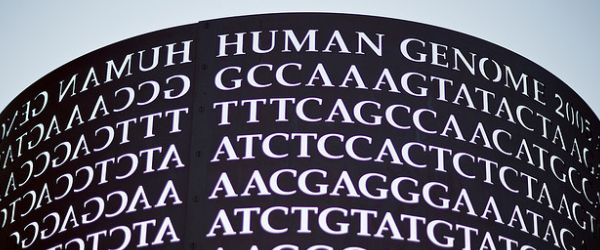Learn-omics! What is that “Omics” I keep Stumbling Upon?

Genomics, transcriptomics, proteomics, metabolomics – words that in 2015 sound very familiar even to a freshman in any biology field. Although most have heard those words before, I keep encountering students or even post-graduates who find it difficult to explain what they are. So, to make things easier here is a peek behind the curtains of “omics technologies”.
Word origin
In order for someone to be able to explain something, he or she should know where it comes from.
As we all know, scientists keep using Latin and Greek terminology in various fields and this also applies to our predicament.
Even from ancient Greece, medical terms used the suffix –ome, which later passed to Latin as variant –oma (i.e. lipoma, melanoma) and when in biology the word gene emerged, researchers quickly used the word genome to easily encapsulate a field of studies in a single word.
So, from a linguistic point of view, genome came first, and genomics after. Genomics is used to emphasize the technologies which were used to study the…genome, and if you are wondering which genome, well that’s yours.
Yes! With the human genome project being all the rage in the 90s, the term genomics was used for the first time by the consortium that was assembled in 1986. More specifically, after a long day mapping part of the human genome, beer and McDonald’s was the magic combination for Tom Roderick to propose the word to his colleagues, Frank Ruddle and Victor McKusick. He proposed it only as an idea to call a potential new scientific journal of theirs, which today is well known as Genomics.
Genomics was the first “omics” terminology used, far earlier than the second in 1995, proteomics, and so on.
So there you are, now you know where “Omics” come from, but why are they so important?
The need of inventing “Omics”
The need to create these words rose from the need to study holistic (that’s right people, another Greek word) or, if you prefer, the totality of the biology of the systems (systems biology). Soon, scientists understood that studying one gene or one metabolite or one mRNA gives little knowledge. Modern technology allows scientists to study the whole transcriptome, genome or proteome of an organism giving more and more information, so now the challenge is not to generate data, but to interpret them and to relate results of different omics technologies (i.e. trancriptomics with metabolomics).
As the technology advances and new ideas come forth, new technologies and terminologies arise. Phenomics, lipidomics, catalomics, connectomics are some of them, translating to the holistic approach of studying phenotypes, lipids, enzymes and neural connections.
So, stop thinking gene by gene, enzyme by enzyme, metabolite by metabolite and broaden your horizons to apply omics technologies for a wider knowledge of systems biology. Here are some examples on how to achieve it.
Genomics
The technologies that are focused on studying the genome of an organism including genes, exons, introns, promoters, transcription factors, and many other genome-related functions.
Technologies used: Next generation sequencing (i.e. Illumina HiSeq), Sanger sequencing, de novo assembling, bioinformatics.
Transcriptomics
The technologies that are focused on studying the transcriptome of an organism.
Technologies used: Next generation sequencing (RNA sequencing), bioinformatics, microarrays, real-time PCR.
Proteomics
The technologies that are focused on studying the proteins of an organism or the proteome.
Technologies used: Enzyme-linked immunosorbent assay (ELISA), mass spectrometric immunoassay (MSIA)
Metabolomics
The technologies that are focused on studying the metabolome or the secondary metabolites of an organism, such as amino acids, sugars, phosphates, nitrogen containing compounds, polyols, etc.
Technologies used: Gas chromatography fused with mass spectrometry (GC-MS), liquid chromatography fused with mass spectrometry (LC-MS).
Lipidomics
The technologies that are focused on studying the cellular lipids of an organism or a biological system.
Technologies used: Electrospray ionization (ESI) and matrix-assisted laser desorption/ionization (MALDI).
Catalomics
The technologies that are focused on studying enzymes (catalysts) or other biocatalysts of an organism or a system.
Technologies used: “Click” reactions in chemistry.
I think you might have stopped reading by now, so these are only some examples of “Omics” technologies and ways to approach them. This is just a brief glimpse into the technology that is here to stay. Now, it is in our hands to exploit it so basic and applied research can reap the benefits.
“Before beginning a Hunt, it is wise to ask someone what you are looking for before you begin looking for it.”
Winnie the Pooh
References
- Babiniotis G. (2009). The history of the words.
- Daniel C. Liebler (2002). Introduction to proteomics: tools for the new biology. Totowa, NJ: Humana Press.
- Karunakaran A. Kalesh et. al.(2010). The use of click chemistry in the emerging field of catalomics. Org Biomol Chem. 8(8):1749-62
- Kopka J. (2006). Current challenges and developments in GC-MS based metabolite profiling technology. J Biotechnol. Jun 25;124(1):312-22.
- McGettigan PA. (2013). Transcriptomics in the RNA-seq era. Curr Opin Chem Biol. Feb;17(1):4-11.
- Yadav SP. (2007). The Wholeness in Suffix -omics, -omes, and the Word Om. Journal of Biomolecular Techniques. Dec 18(5):277.
- McCouch SR. (2001). Genomics and Synteny. Plant. Physio. Jan;125(1):152-5.
- Wenk MR (2005). The emerging field of lipidomics. Nat Rev Drug Discov 4 (7): 594–610.